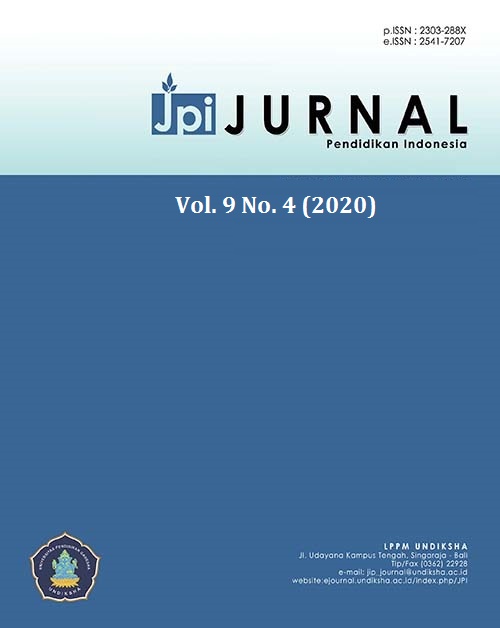Development of Learning Materials Integrated of Social Aritmetic and Accounting
DOI:
https://doi.org/10.23887/jpi-undiksha.v9i4.17527Keywords:
Social Arithmetic, Learning Materials, ADDIEAbstract
The development of integrated learning materials of social arithmetic and accounting was carried out with the aim of making prototypes of learning materials that integrated social arithmetic and accounting. The development combines social arithmetic material as a calculation process and accounting for the preparation of financial statements. This development uses the ADDIE model. The test of the effectiveness of learning materials as a result of the development was carried out by experimental research using posttest group design. The research subjects were students of Middle School 2 Gondang Bojonegoro East Java class VIII A as the experimental class and class VIII B as the control class. The research subjects consisted of 56 students. 28 students in the experimental class, 28 in the control class. The results of the study show that the learning materials developed are feasible and effective to be used in learning integrated social arithmetic and accounting. The results also showed that there were differences in student learning outcomes in the experimental class and the control class. This can be seen from the value of the average posttest in the experimental class is 95.89 in the control class is 87.67 so that the difference is 8.22.
References
Abubakar, W. (2016). Analytical Problem Solving Skills At Social Arithmetic In Project Based Learning In Grade 3 SMP Islam Athirah Bukit Baruga. Daya Matematis: Jurnal Inovasi Pendidikan Matematika, 4(3), 380-392. https://doi.org/10.26858/jds.v4i3.2930
Aladejana, F., & Aderibigbe, O. (2007). Science Laboratory Environment And Academic Performance. Journal of Science Education and Technology, 16(6), 500-506. https://doi.org/10.1007/s10956-007-9072-4
Basri, B. (2017). Signifikansi Desain Pembelajaran dalam Menunjang Kesuksesan Mengajar. Nizham Journal of Islamic Studies, 1(2), 190-203. https://www.learning.metrouniv.ac.id/index.php/nizham/article/view/855
Budiawati, Y. S. R., & Kantun, S. (2016). Analisis tingkat kelayakan bahan ajar ekonomi yang digunakan oleh guru di SMA Negeri 4 Jember. Jurnal Pendidikan Ekonomi: Jurnal Ilmiah Ilmu Pendidikan, Ilmu Ekonomi dan Ilmu Sosial, 9(1), 129-146. https://jurnal.unej.ac.id/index.php/JPE/article/view/3384
Cheung, L. (2016). Using the ADDIE Model of Instructional Design to Teach Chest Radiograph Interpretation. Journal of Biomedical Education, 16, 1-6. https://doi.org/10.1155/2016/9502572
Fhatulloh, M. R., & Yusup, M. (2017). Implementasi Guru Dalam Mendesain Proses Pembelajaran PAI. Atthulab: Islamic Religion Teaching and Learning Journal, 2(2), 133-139. https://doi.org/10.15575/ath.v2i2.2790
Gagne, M. (1996). The Conditions of Learning: Training Applications. Harcourt Brace.
Hasnawati, H., & Ardin, A. (2010). Efektivitas Penerapan Pembelajaran Konstruktivis terhadap Hasil Belajar Matematika. Jurnal Pendidikan Matematika, 1(2), 114-121. https://dx.doi.org/10.36709/jpm.v1i2.1948
Jayanti, M., & Wiratomo, Y. (2017). Perancangan Media Siap UN Matematika SMP Berbasis Android. SAP (Susunan Artikel Pendidikan), 2(1), 22-32. http://dx.doi.org/10.30998/sap.v2i1.1722
Joyce, B., Weil, M., & Calhoun, E. (2011). Models of Teaching (Model-Model Pengajaran). Pustaka Pelajar.
Lestari, P. B., & Hartati, T. W. (2017). Analisis Pengembangan Bahan Ajar Mikrobiologi Berbasis Inkuiry di IKIP Budi Utomo Malang. Bioedukasi: Jurnal Pendidikan Biologi, 10(2), 1-6. https://doi.org/10.20961/bioedukasi-uns.v10i2.11332
Miarso, Y. H. (2011). Menyemai Benih Teknologi. Kencana Prenada Group.
Molenda, M. (2015). In search of the elusive ADDIE model. Performance Improvement, 54(2), 40-42. https://doi.org/10.1002/pfi.21461
Muchyidin, A. (2017). Pengaruh Penggunaan Bahan Ajar Matematika Bersuplemen Komik Terhadap Kemandirian Belajar Siswa. Eduma: Mathematics Education Learning and Teaching, 6(1), 43-51. http://dx.doi.org/10.24235/eduma.v6i1.1667
Mufarizuddin. (2018). Improving learning outcomes by using think pair share (TPS) cooperative learning model at primary school students. Jurnal Pendidikan Indonesia, 7(2), 77-85. https://doi.org/10.23887/jpi-undiksha.v7i2.10469
Nichols Hess, A., & Greer, K. (2016). Designing for Engagement: Using the ADDIE Model to Integrate High-Impact Practices Into an Online Information Literacy Course. Communications In Information Literacy, 10(2), 264-282. https://doi.org/10.15760/comminfolit.2016.10.2.27
Nurjaya, G. (2012). Pengembangan bahan ajar metode pembelajaran bahasa dan sastra indonesia berbasis pembelajaran kooperatif jigsaw untuk meningkatkan pemahaman dan kemampuan aplikatif mahasiswa. Jurnal Pendidikan Indonesia, 1(2), 102-111. https://doi.org/10.23887/jpi-undiksha.v1i2.4490
Nurliawati, L., Mujasam, Yusuf, I., & Widyaningsih, S. W. (2017). Lembar kerja peserta didik (LKPD) berbasis problem solving polya. Jurnal Pendidikan Indonesia, 6(1), 72-81. https://doi.org/10.23887/jpi-undiksha.v6i1.9183
Prastowo, A. (2012). Panduan kreatif membuat bahan ajar inovatif. Diva Press.
Prawiradilaga, D. S. (2009). Prinsip Desain Pembelajaran. Prenada Media Group.
Pribadi, B. A. (2010). Desain sistem pembelajaran. Dian Rakyat.
Qomariah, S. S., & Sudiarditha, K. R. (2016). Kualitas media pembelajaran, minat belajar, dan hasil belajar siswa: studi pada mata pelajaran ekonomi di kelas X IIS SMA Negeri 12 Jakarta. Jurnal Pendidikan Ekonomi dan Bisnis, 4(1), 33-47. https://doi.org/10.21009/JPEB.004.1.3
Sanjaya, W. (2010). Perencanaan dan Desain Sistem Pembelajaran. Kencana Prenada Group.
Setyosari, P. (2010). Metode Penelitian Pendidikan dan Pengembangan. Kencana.
Smaldino, E. (2008). Instructional Technology And Media For Learning (Teknologi Pembelajaran Dan Media Untuk Belajar). Kencana Prenada Group.
Solaikah, Afifah, D. S., & Suroto. (2013). Identifikasi kemampuan siswa dalam menyelesaikan soal aritmatika sosial ditinjau dari perbedaan kemampuan matematika. Jurnal Pendidikan Matematika STKIP PGRI Sidoarjo, 1(1), 97-106.
Sumarmo, U., Hidayat, W., Zukarnaen, R., Hamidah, & Sariningsih, R. (2012). Kemampuan dan disposisi berpikir logis, kritis, dan kreatif matematik (Eksperimen terhadap siswa SMAmenggunakan pembelajaran berbasis masalah dan strategi think-talk-write). Jurnal Pengajaran MIPA, 17(1), 17-33.
Downloads
Published
Issue
Section
License
Authors who publish with the Jurnal Pendidikan Indnesia agree to the following terms:
- Authors retain copyright and grant the journal the right of first publication with the work simultaneously licensed under a Creative Commons Attribution License (CC BY-SA 4.0) that allows others to share the work with an acknowledgment of the work's authorship and initial publication in this journal.
- Authors are able to enter into separate, additional contractual arrangements for the non-exclusive distribution of the journal's published version of the work (e.g., post it to an institutional repository or publish it in a book), with an acknowledgment of its initial publication in this journal.
- Authors are permitted and encouraged to post their work online (e.g., in institutional repositories or on their website) prior to and during the submission process, as it can lead to productive exchanges, as well as earlier and greater citation of published work. (See The Effect of Open Access)








